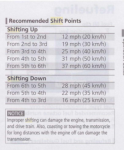question when should I switch gears on yamaha r3. When I started to drive switched them at 7-8k r/min , my brother he is a racer told me to bring them up to 10-12.
Just looking for another opinion, not to kill engine.
Just looking for another opinion, not to kill engine.



















